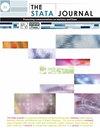集群水平的集群随机对照试验分析:家族指挥。
IF 3.2
2区 数学
Q1 SOCIAL SCIENCES, MATHEMATICAL METHODS
引用次数: 0
摘要
在这篇文章中,我们介绍了一个新的命令,clan,它对集群随机试验进行集群级分析。该命令简化了对个体和集群级协变量的调整,也可以考虑分层设计。它可以用于分析连续、二进制或速率结果。本文章由计算机程序翻译,如有差异,请以英文原文为准。
Cluster randomized controlled trial analysis at the cluster level: The clan command.
In this article, we introduce a new command, clan, that conducts a cluster-level analysis of cluster randomized trials. The command simplifies adjusting for individual- and cluster-level covariates and can also account for a stratified design. It can be used to analyze a continuous, binary, or rate outcome.
求助全文
通过发布文献求助,成功后即可免费获取论文全文。
去求助
来源期刊

Stata Journal
数学-统计学与概率论
CiteScore
7.80
自引率
4.20%
发文量
44
审稿时长
>12 weeks
期刊介绍:
The Stata Journal is a quarterly publication containing articles about statistics, data analysis, teaching methods, and effective use of Stata''s language. The Stata Journal publishes reviewed papers together with shorter notes and comments, regular columns, book reviews, and other material of interest to researchers applying statistics in a variety of disciplines.
 求助内容:
求助内容: 应助结果提醒方式:
应助结果提醒方式:


